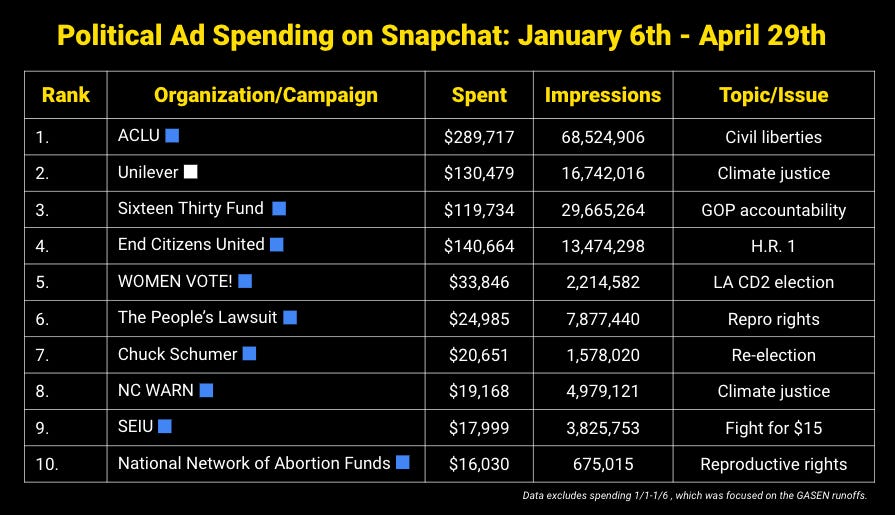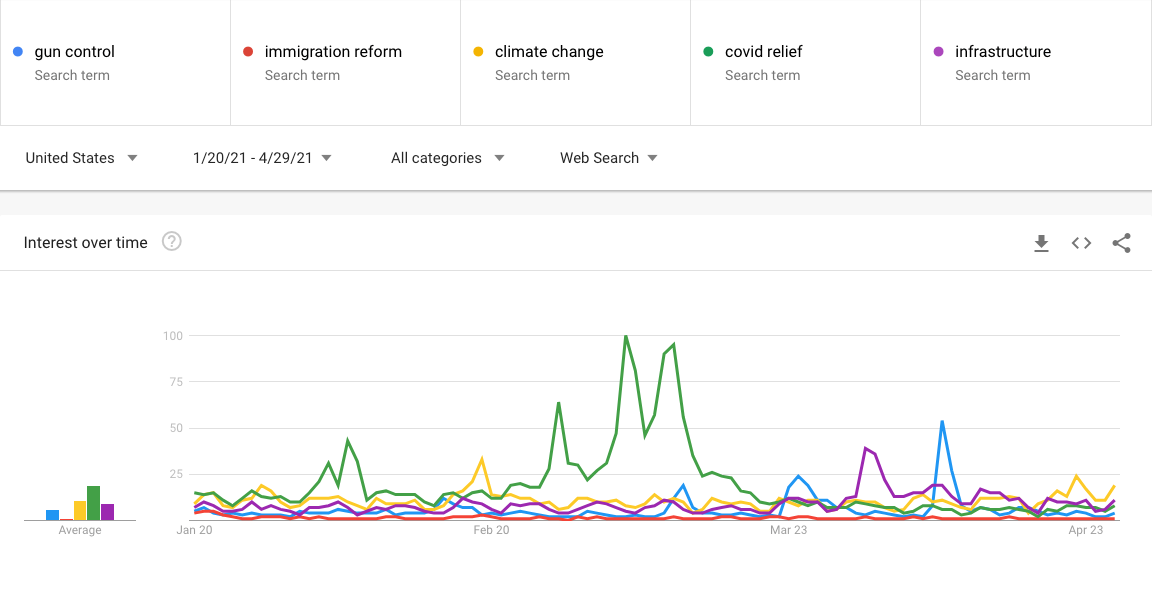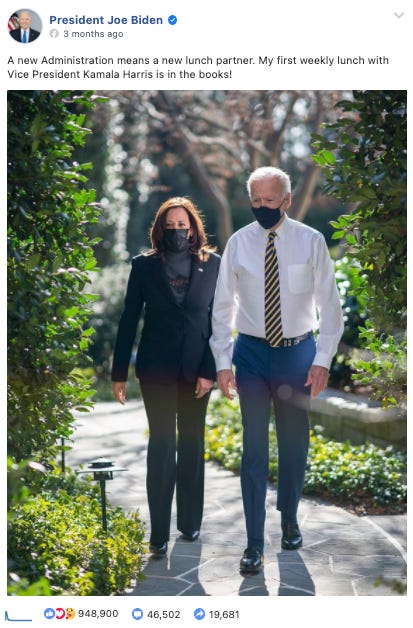FWIW: 100 glorious days
A digital recap of the Biden administration’s first 100 days
It’s been 101 days since President Biden and Vice President Harris took office, and in that time they’ve delivered shots in arms, checks in bank accounts, and lots of sighs of relief to the American people. In this week’s FWIW, we take a look at how these first 100 days of the new administration have played online, from the White House’s own social growth and engagement, to how much outside groups have spent promoting or opposing the Biden agenda.
But first...
By the numbers
Here are the top political ad spenders on Facebook last week:
The Koch brothers’ Americans for Prosperity recently ramped up their spending on Facebook, launching new ads attacking the Biden administration’s proposed infrastructure bill, and continuing to slam the American Rescue Plan.
Their main lines of attack are very predictable, hitting the popular legislation on its price tag and tying it to big government, tax increases, and health care.
On the left, End Citizens United continues to run a large scale advertising campaign on Facebook and other platforms in support of HR 1, specifically the bill’s components involving banning dark money and ending corruption in politics.
FWIW, here are the top political ad spenders on Google platforms last week:
These top spenders basically remained the same since last week, except Sen. Majority Leader Chuck Schumer’s re-election campaign made the top 10 after launching a 🔥 new ad in which claims that he’s “not a spandex guy” while he bikes around Brooklyn.
His campaign also became a major spender on Snapchat advertising, where there was more movement than usual last week. Here are the top political advertisers on Snapchat YTD:
Liberal groups continue to dominate spending on the platform, with Somos Votantes launching a new ad campaign last week to support the American Jobs Plan. They’re currently targeting Latino audiences in CO, NC, NV, FL, PA and AZ.
Deep dive: 100 glorious days
Trending topics
These past 100 days have been defined by a combination of legislative accomplishments, steady economic and public health recovery, and a cumulative sigh of relief across the nation. Looking at Google Trends search data, we can compare Americans’ interest in several of the major issues of this first period of the Biden presidency. Spoiler alert: COVID relief was far and away the most searched topic.
Despite the right-wing media’s efforts to use a “border crisis” to put the Biden administration on the ropes, search interest for “illegal immigration” and “border crisis” did not peak in any way close to the above topics. Information about COVID relief was in high demand during and after the passage of the American Rescue Plan, and the introduction of the American Jobs Plan also got people thinking about infrastructure. Meanwhile, “Gun control” searches spiked following mass shootings in Boulder and Atlanta.
The Outside Game
While the White House certainly has an enormous earned media advantage via their “Bully Pulpit,” they still have to contend with a decentralized information ecosystem - which is where outside advocacy groups come in.
Progressive nonprofits and issue advocacy groups have spent several million dollars on digital ads promoting the administration’s priorities and accomplishments during the first 100 days. Across the aisle, and with a few exceptions, there have been very limited digital paid media efforts on the right to counter these ad campaigns.
One thing we’ve noticed is that Democrats and Dem-friendly groups are going hard (you could even say they’re in array) on promoting the American Rescue Plan. Groups like SEIU, Community Change Action, the DNC, and others have been investing hundreds of thousands of dollars in ads thanking the Biden administration and Democratic senators for passing the COVID relief package, highlighting $1,400 checks, school reopening, and vaccine access:
This kind of paid air cover is critical in communicating the administration’s successes day-in and day-out, and there’s no sign of these types of campaigns slowing down. Just this week, the new organization Building Back Together announced its first wave of paid media in support of the Biden agenda. 🏆
Other outside groups have been taking advantage of the Democratic Trifecta in Washington by urging Biden to take even more actions in his first 100 days. The ACLU alone has already spent over $700,000 on Facebook ads alone pushing for reform on policing, marijuana, student loan debt cancellation, voting rights, and more; End Citizens United has been pushing hard across platforms for Democracy Reform via H.R. 1; and the Environmental Defense Fund has spent over $70k on ads advocating for going “bold on climate” - just to name a few.
The Virtual White House
The White House itself has been using its own channels to push its message on everything from appointments to legislation in its first 100 days. While Biden has had to play a little catch up in terms of audience growth compared to his predecessor, the official White House social media accounts have grown at a steady rate.
Here’s how much the followings of the White House and Biden’s Facebook page has grown in his first 100 days:
On Facebook, the president’s accounts have grown steadily since his inauguration, with the White House page getting ~150,000 new followers around the end of March, when vaccine administration really started to accelerate. Biden’s POTUS page and the new White House page now have more followers than Trump’s respective pages did by the end of his term, but are all significantly behind Donald Trump’s personal page, which had over 35 million followers before he was banned.
Top Biden posts by interactions
Despite the enormous popularity of the COVID relief bill and the packed legislative agenda of this administration, the most popular social media posts by Joe Biden and @ White House on both Facebook and Instagram have been upbeat photo posts just featuring the President himself.
Here’s the most interacted-with Facebook post from team Biden in his first 100 days:
Meanwhile, on Instagram, the top post was this image of the President with his dogs in the Oval Office.
After four years of fear and loathing, the new White House digital teams are clearly trying to project some levity, optimism, and hope - and their audiences are eating it up.
What do you think of the new administration’s social media tactics? Be sure to let us know on Twitter @fwiwnews. 🤔 … and that’s it for FWIW this week! If you enjoyed reading this week’s issue, make sure to click the button below and share it on Twitter!













